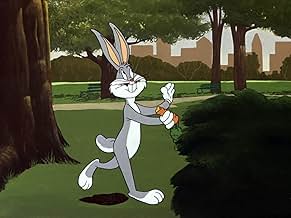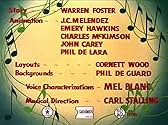Ajouter une intrigue dans votre langueBugs, the entrepreneurial bunny, reads a classified ad for a hurdy gurdy and monkey and decides to go into the music business.Bugs, the entrepreneurial bunny, reads a classified ad for a hurdy gurdy and monkey and decides to go into the music business.Bugs, the entrepreneurial bunny, reads a classified ad for a hurdy gurdy and monkey and decides to go into the music business.
- Réalisation
- Scénario
- Casting principal
Mel Blanc
- Bugs Bunny
- (voix)
- …
Avis à la une
Robert McKimson's 'Hurdy-Gurdy Hare' suffers from a feeble premise which never offers much of an opportunity for laughs. Bugs Bunny, in an unusually money-grabbing, greedy incarnation, purchases a hurdy-gurdy complete with monkey in order to make some money. When the monkey attempts to swindle him, however, he fires the simian and takes on his role himself. The monkey informs his father (an unattractive reimagining of Gruesome the Gorilla from McKimson's previous 'Gorilla My Dreams'), who comes after Bugs in search of retribution. Set against the dull backdrop of an apartment building, 'Hurdy-Gurdy Hare' feels instantly laboured and unfunny. It never even threatens to come to life once throughout its seven minute runtime and, while it doesn't quite plumb the depths of the studio's very worst output, 'Hurdy-Gurdy Hare' is a cartoon that I could easily live without ever seeing again.
People may be turned off by the nastier version of Bugs Bunny seen here, at times you actually did root for the monkey more. Bugs is not completely out of character though because he is still very funny and is as charismatic as ever. The monkey is very cute and "Gruesome" while not the most memorable or compelling character is no liability to the cartoon either. Several other things are great about Hurdy-Gurdy Hare. The highlight is definitely Carl Stalling's music, which is nothing short of outstanding. Few other composers matched their music with the gags, gestures and visuals as well as Stalling, it is very witty and lush-sounding orchestration. The animation is colourful and fluid, with a remarkable attention to detail. Bugs does look different but not by all means odd, if anything it's interesting, his expressions and the way he moves are very consistent. The dialogue is razor sharp and doesn't cease to entertain, Bugs is nearly always a well-written character and he still has some great lines in Hurdy-Gurdy Hare, once you understand the significance of it the final line is priceless. The gags are just as imaginatively timed and funny, if there was anything laboured I personally didn't see it. The story is paced in a lively way and doesn't come across as predictable at all, helped by that the premise was a clever one in the first place. Mel Blanc does a stellar job as always with the voice characterisations. Overall, once you get past a different Bugs Hurdy-Gurdy Hare is a great cartoon. 9/10 Bethany Cox
I wonder how many people today know what a "hurdy-gurdy" is? According to the Wikipedia, it is "a stringed musical instrument in which the strings are sounded by means of a rosined wheel which the strings of the instrument pass over. This wheel, turned with a crank, functions much like a violin bow. Melodies are played on a keyboard that presses tangents (small wedges, usually made of wood) against one or more of these strings to change their vibrating length, and therefore pitch."
I first remember hearing the term when Donovan had his hit song in 1968 called "The Hurdy Gurdy Man." That's still a great song, and was featured in the recent film, "Zodiac."
Anyway, Bugs is in Central Park in New York and comes across a classified ad in the newspaper stating "Hurdy Gurdy and monkey for sale cheap."
"Hey, I'll go into the music business," he says. Pretty soon, he's walking down the streets of New York pulling this big instrument and having a little chimp sitting on top. Bugs finds out quickly that the little simian is holding out on him with the tip money, so he boots him out and decides to imitate the chimp himself. "Who needs that chiseler," he thinks.
The fun starts when the chimp goes to the zoo and informs this humongous ape what happened to him and the big gorilla breaks out and goes looking for Bugs!
I first remember hearing the term when Donovan had his hit song in 1968 called "The Hurdy Gurdy Man." That's still a great song, and was featured in the recent film, "Zodiac."
Anyway, Bugs is in Central Park in New York and comes across a classified ad in the newspaper stating "Hurdy Gurdy and monkey for sale cheap."
"Hey, I'll go into the music business," he says. Pretty soon, he's walking down the streets of New York pulling this big instrument and having a little chimp sitting on top. Bugs finds out quickly that the little simian is holding out on him with the tip money, so he boots him out and decides to imitate the chimp himself. "Who needs that chiseler," he thinks.
The fun starts when the chimp goes to the zoo and informs this humongous ape what happened to him and the big gorilla breaks out and goes looking for Bugs!
It seems like often when I see portrayals of monkeys belonging to hurdy-gurdy men, the monkeys are real shysters, such as the one who tries to rip off Bugs Bunny here. But of course, "Hurdy-Gurdy Hare" gets really good once the gorilla - presumably Gruesome from "Gorilla My Dreams" - comes after Bugs. Bugs does his usual stuff to avoid getting harmed. True, this was probably one of the cartoons functioning as a place-holder in between the really great ones, but how can you not like what Bugs does? Definitely worth seeing.
Oh, and sorry for the Donovan reference in my summary. In case you're not familiar with that, Donovan sang a song called "Hurdy-Gurdy Man", which recently appeared in the movie "Zodiac".
Oh, and sorry for the Donovan reference in my summary. In case you're not familiar with that, Donovan sang a song called "Hurdy-Gurdy Man", which recently appeared in the movie "Zodiac".
While director McKimson created a gem of a cartoon in Hurdy Gurdy Hare, the real genius in this cartoon is the music arrangement by Carl Stalling. When Gruesome Gorilla pursues Bugs through the byways of Manhattan, two musical themes predominate, one for our hero and the other for the ape. The two melodies intertwine so intimately, it's hard to tell that there are two, not one. This reaches its apex when Bugs takes to a ladder to escape his foe. He climbs up and down the ladder, while Gruesome pulls the ladder up or down so Bugs always ends up face-to-face with him. A xylophone (or, perhaps a marimba) plays a rising or falling scale to the motion of the ladder, while the rest of the orchestra plays a similar scale for Bugs, musically showing simultaneous up and down movement. In fact, the only flaw in this film is when, near the end, Bugs misquotes the proverb, "Music has charms to soothe the savage beast." Oh, well - anything can happen in a cartoon.
Le saviez-vous
- AnecdotesBugs Bunny' final line, "I sure hope Petrillo doesn't hear about this!", refers to James C. Petrillo, the then-current president of the American Federation of Musicians, and his disapproval of recorded music, as this short was being created.
- Citations
Bugs Bunny: I've seen you before. I never forget a face. But in your case, I'll make an exception.
- ConnexionsFeatured in What's Up Doc?: Épisode #1.25 (1993)
- Bandes originalesForty-Second Street
(uncredited)
Music by Harry Warren
Played at the beginning when Bugs is reading the newspaper
Also played when Bugs mimics a monkey
Also played when the Gorilla emerges from underneath the sidewalk
Meilleurs choix
Connectez-vous pour évaluer et suivre la liste de favoris afin de recevoir des recommandations personnalisées
Détails
- Date de sortie
- Pays d’origine
- Site officiel
- Langue
- Aussi connu sous le nom de
- Hare-dy Gurdy Hare
- Société de production
- Voir plus de crédits d'entreprise sur IMDbPro
- Durée
- 7min
- Mixage
- Rapport de forme
- 1.37 : 1
Contribuer à cette page
Suggérer une modification ou ajouter du contenu manquant








